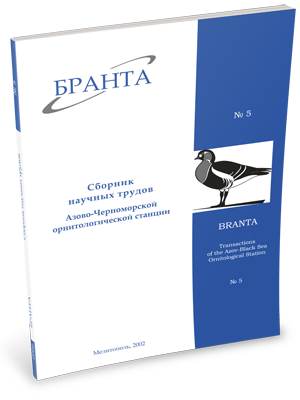
Transactions
of the Azov-Black Sea Ornithological Station



Migration, concentrations and conservation of Crane in the Middle Europe (review).
Prange H.
Migration: The autumn migration on the western European route was used in 2000 by about 130 000 cranes nearly 125 000 of which made simultaneous stopovers for resting in Germany. Contrary to before 1990, the largest number comes from north-eastern Europe. Therefore, the biggest flocks have been observed in inner Germany, mainly between the Baltic Sea coast and Berlin. Birds ringed in Finland have their resting places mainly in the back country, whereas cranes from Scandinavia are mostly found in the Ruegen-Bock region near the Baltic Sea coast.
While in autumn between August and November/December the resting grounds are occupied for several months, only short stopovers in suitable wetlands are made during the spring migration which is less striking in central Europe and, with exception of the Ruegen-Bock region, leaves traditional resting grounds abandoned over a long period. At present, up to a third of all cranes on the west European migration route stay for the winter in France which means a shorter distance for the cranes to the breeding areas.
The Baltic-Hungarian route is used by about 80 000 cranes every year, most of them interrupting their migration at the Hortobagý-Puszta in Hungary for about eight weeks in spring and autumn.
On both migration routes crane numbers have increased to the threefold in the last two decades. This goes back to growing population numbers and a shift of the stop-off route of north-eastern European cranes in western direction. The smaller part of the flocks chooses its stop-off in the opposite direction: about 10% of the Swedish cranes take off in eastern direction, while about 20% of the cranes of Finish origin fly west, irrespectively of their home place of ringing in Finland.
The nearly blanket coverage of rest monitoring in Germany, France and Hungary allows to draw conclusions about the population numbers in the countries of provenance, which turned out to be higher than so far assumed (see table 6). Winding up, attention is paid to required protection measures on European level and also to the future tasks of the European Crane Working Group.
Autumn crane resting
Areas visited by cranes are shortly distinguished between grounds for gathering, gathering and resting as well as for wintering. In resting and wintering regions, these sites are usually visited for expanded periods; birds on their migration route use them for a short stopover of some weeks only.
The described areas include grounds for roosting, feeding and mostly also pre-gathering points, where the cranes stage before taking off to smaller places for the night. They should have a protection status similar to that of the sleeping sites.
In Germany, about 95% of the 130 000 migrating cranes are monitored in 2000. In the Ruegen-Bock region, the number of Scandinavian cranes has trebled in the last three decades up to about 40 000 cranes; counting in the inland of Germany revealed about the tenfold up to 80-90 000 birds. For the year 2000, data from 40 resting places with more than 95% of all cranes have been analysed. On some selected sites, activities in the resting period differ considerably depending on the place on the migration route and the local conditions.
Despite the fact that most roosting grounds are protected and safe, new disturbances arise from the increasing number of visitors to attractive places and from wind power plants which must be kept at an appropriate distance from crane-visited resting areas. Crane conservationists are facing new tasks in connection with artificial feeding for avoiding crop damage, communal outreach, environmental education, and visitors control, but also in the participation in landscape planning with attention to purposeful wetland restoration.
Read the paper in a PDF file